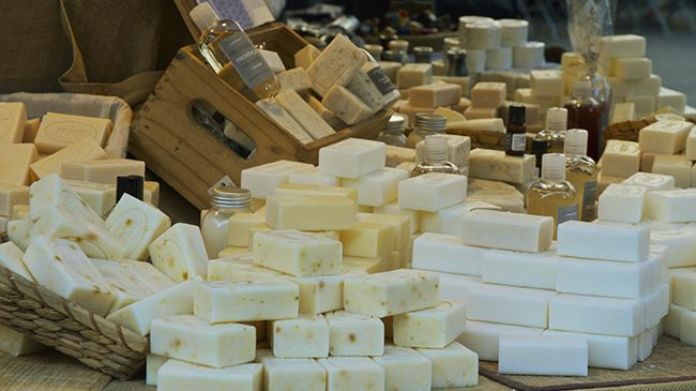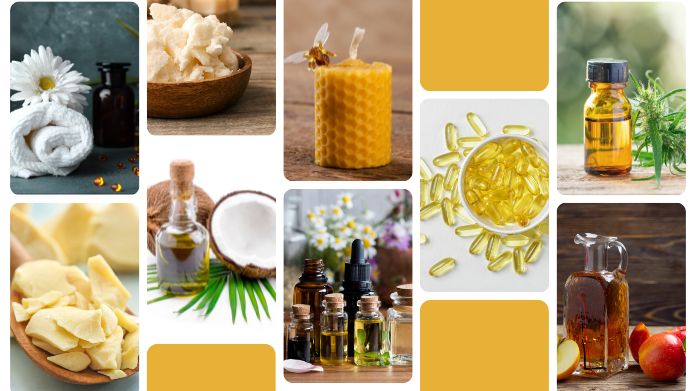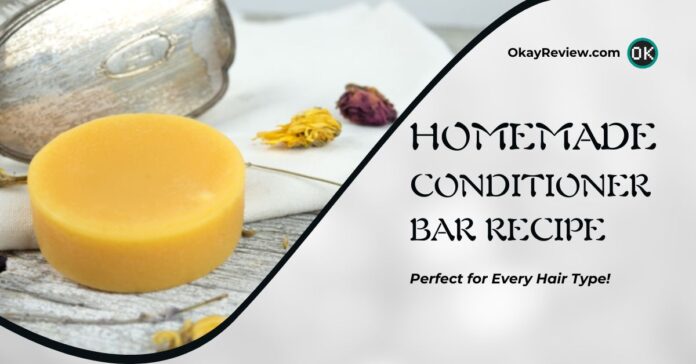Embarking on a journey towards sustainable beauty and personalized hair care, the homemade conditioner bar recipe is a delightful discovery for those seeking natural solutions for their hair.
These conditioner bars, suitable for all hair types, are not just a nod to eco-conscious living but also a testament to the effectiveness of natural ingredients in nurturing and maintaining healthy hair.
This guide delves into homemade conditioner bars, exploring their benefits, key ingredients, and a step-by-step recipe tailored to everyone.
Whether you have curly, straight, thick, or fine hair, this conditioner bar recipe is designed to cater to the unique needs of your locks, ensuring that your hair care routine is as environmentally friendly as it is beneficial for your hair.
Join us as we uncover the secrets to crafting your conditioner bar, a simple yet impactful step towards a more sustainable and hair-friendly lifestyle.
Table of Contents
What Are Conditioner Bars?
 Conditioner bars are a revolutionary approach to hair care, embodying both efficiency and environmental consciousness.
Conditioner bars are a revolutionary approach to hair care, embodying both efficiency and environmental consciousness.
Unlike traditional liquid conditioners, these bars come in a solid form, resembling a bar of soap, but are specifically designed for hair conditioning.
The concept behind a conditioner bar is simple yet innovative – it provides all the nourishing benefits of a regular conditioner without the excess water content and plastic packaging.
This makes them not only eco-friendly but also incredibly travel-friendly and space-efficient. The magic of a conditioner bar recipe lies in its concentrated formula.
Manufacturers typically craft these bars from natural ingredients like cocoa butter, shea butter, essential oils, and other hair-loving components. Each ingredient is chosen for its ability to hydrate, detangle, and add shine to your hair.
When applied, the bar lightly coats the hair with these beneficial ingredients, leaving it soft, manageable, and beautifully conditioned.
Adopting a conditioner bar recipe into your hair care routine is a step towards sustainable living; it will also used when something gets stuck on the hair, it makes it simple.
These bars last longer than traditional conditioners, reduce plastic waste, and eliminate the need for harmful chemicals.
They are a testament to how small changes in our daily routines can contribute to a more significant environmental impact, all while keeping our hair healthy and happy.
Benefits of Using Homemade Conditioner Bars
Using homemade conditioner bars offers many benefits, making them a smart choice for anyone looking to enhance their hair care routine while being mindful of the environment.
Here are some key advantages:
- Eco-Friendly: Homemade conditioner bars significantly reduce plastic waste. Since they don’t require plastic bottles, they are a more sustainable option than traditional liquid conditioners.
- Cost-Effective: Following a conditioner bar recipe at home will likely save money in the long run. These bars last longer than liquid conditioners, offering more applications per unit.
- Travel Convenience: Their compact and spill-proof nature makes conditioner bars ideal for travel. They take up less space and can easily be carried in hand luggage without any liquid restrictions.
- Natural Ingredients: You have complete control over the ingredients by creating your conditioner bar recipe. It means avoiding harsh chemicals and synthetic fragrances and opting for natural, hair-nourishing components.
- Customization: Homemade conditioner bars can be tailored to suit specific hair types and needs. Whether you have a dry, oily, or sensitive scalp, you can adjust the ingredients in your recipe accordingly.
- Reduced Carbon Footprint: Since conditioner bars are more concentrated and require less water in their production, they contribute to a lower carbon footprint compared to their liquid counterparts.
- Healthy Hair: The natural oils and butter in conditioner bar recipes are excellent for hair health. They provide deep nourishment, promote shine, and help in reducing frizz and tangles.
- Minimalist and Efficient: Embracing the use of conditioner bars aligns with a minimalist lifestyle, reducing clutter in your bathroom. Their efficiency in use and storage makes them a practical choice for modern, eco-conscious individuals.
Key Ingredients for Your Conditioner Bar Recipe
 Creating your conditioner bar recipe is a crafty endeavor and a journey into natural hair care. The key to a successful conditioner bar lies in its ingredients.
Creating your conditioner bar recipe is a crafty endeavor and a journey into natural hair care. The key to a successful conditioner bar lies in its ingredients.
Here are some essential components that you should consider including in your conditioner bar recipe:
- Cocoa Butter: A star ingredient, cocoa butter is a natural emollient, making it ideal for moisturizing and nourishing your hair. It adds a luxurious feel to your conditioner bar recipe.
- Shea Butter: Renowned for its conditioning properties, it is perfect for soothing the scalp and providing moisture to dry hair. It’s a must-have for any conditioner bar recipe aiming to enhance hair softness.
- Coconut Oil: This oil is a powerhouse for hair health. It penetrates the hair shaft, providing deep conditioning and helping to reduce protein loss in hair.
- Beeswax: Beeswax adds stability to your conditioner bar, ensuring it holds its shape. It also assists in moisture retention, making hair smooth and lustrous.
- Essential Oils: Not only do they add a pleasant fragrance, but essential oils like lavender, peppermint, or rosemary can also promote scalp health and hair growth.
- Carrier Oils: Jojoba, argan, and avocado oils are excellent choices. They are similar to natural scalp oils, perfect for hydrating and detangling hair.
- Vitamin E: This acts as a preservative and an antioxidant, helping to keep your conditioner bar fresh and prolong its shelf life.
- Natural Emulsifiers: Ingredients like BTMS (Behentrimonium Methosulfate) are crucial for effectively blending oil and water components, ensuring your conditioner bar recipe has a smooth, consistent texture.
- Herbal Extracts: Ingredients like nettle, chamomile, or green tea can add extra nourishing properties to your conditioner bar, promoting healthy hair growth and scalp care.
- Apple Cider Vinegar: A small amount can help balance the pH of your conditioner bar, making it more hair-friendly, especially for those with sensitive scalps.
Conditioner Bar Recipe: Step-by-step guide
Creating your conditioner bar is both a fun and rewarding process. Here’s a detailed step-by-step guide to making your very own conditioner bar.
This conditioner bar recipe is designed to be simple yet effective, perfect for beginners and seasoned DIY enthusiasts alike.
Step 1. Melt the Base
Begin by setting up your double boiler on medium heat. Add the cocoa butter, shea butter, coconut oil, and beeswax into the boiler.
Stir occasionally until everything is completely melted and combined. This blend forms the moisturizing base of your conditioner bar recipe.
Step 2. Add the BTMS-50
Once your base is melted, stir in the BTMS-50. This ingredient is crucial as it acts as an emulsifier, ensuring your bar has a smooth texture and conditions your hair effectively.
Step 3. Incorporate Vitamin E and Essential Oils
After the BTMS-50 is fully integrated, remove the mixture from heat. Stir in the vitamin E oil and your chosen essential oils.
Vitamin E is a natural preservative and antioxidant; essential oils give a pleasant smell and hair benefits.
Step 4. Balance with Apple Cider Vinegar
Next, gently stir in the apple cider vinegar. This ingredient contributes to the pH balance of your conditioner bar, making it more hair-friendly.
Step 5. Pour into Molds
Pour the slurry into your silicone molds with caution. Silicone molds are ideal as they allow easy removal once the bars are set.
Step 6. Let it Set
Allow the bars to cool and set. It can take several hours to overnight, depending on the temperature and humidity of your environment.
Resist the temptation to hurry this process; patience ensures your bars are correctly set.
Step 7. Unmold and Store
Once completely set, gently remove the bars from the molds. Store them in a cool, dry place until you can use them.
Step 8. Usage
To use, wet your hair and the bar. You may rub the bar between your hands or straight onto your hair. Massage into hair and scalp, then thoroughly rinse.
How to Use Conditioner Bars?
Using conditioner bars is a simple yet effective way to nourish your hair, and it’s a great step towards embracing more sustainable beauty practices.
If you’ve just made your own using a conditioner bar recipe or purchased one, here’s how to use it effectively:
- Ensure your hair is thoroughly wet before using the conditioner bar.
- Briefly hold the bar under warm water to soften it.
- Make a lather with your hands before applying it to your hair, or glide it straight over your hair strands, focusing on the mid-lengths to the ends.
- Massage the conditioner gently into your hair and scalp.
- Allow the conditioner to remain in your hair for a few minutes to promote deep nourishment.
- Rinse your hair thoroughly, making sure no residue is left.
- Proceed to dry and style your hair as usual.
- Keep the conditioner bar in a dry place to extend its lifespan.
Our Thoughts
Adopting a homemade conditioner bar recipe offers excellent care for all hair types. These bars provide essential nourishment and rejuvenation for your hair and support environmental sustainability.
Making conditioner bars signifies a commitment to a healthier, eco-friendly hair care routine that meets your requirements.


The step-by-step guide for making a conditioner bar is helpful, especially for those looking for an eco-friendly alternative to bottled conditioners. I love the use of natural ingredients for healthy hair. A section on customizing recipes for different hair types would be a great addition.